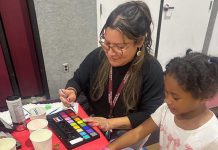Hollister
– Past the gym and tennis courts, way in the back of the school,
five senior boys in the advanced auto shop class looked proudly
through their protective goggles at the engine they rebuilt.
Hollister – Past the gym and tennis courts, way in the back of the school, five senior boys in the advanced auto shop class looked proudly through their protective goggles at the engine they rebuilt.
Thomas Mansfield, 17, has taken vocational science classes at San Benito High School since he was a freshman. Next fall, he has plans to attend Universal Technical Institute for automotive school. Another student, Greg Valenzuela, also 17, is hoping to pursue a career in physical therapy, but took the course so he could learn more about how an automobile works.
“My mom told me I need to be able to work on the car when I get it,” Valenzuela said.
While their reasons for taking the courses vary, according to Cindy Cordova, the director of educational services for SBHS, nearly all students at the school – boys and girls alike – take one or more career technical education courses during their four years of high school.
Dave Matuszak, who heads the Santa Clara County regional occupational program, said San Benito High School’s program is one of the largest in the area, with 11 classes, including auto shop and computer hardware repair.
Career technical education has gained increased attention and funding this year, with Gov. Arnold Schwarzenegger placing an emphasis on these programs in his 2006-07 education budget. This budget pledged not only continued funding, but also allocated an additional $40 million toward the purchase of new equipment and materials for California’s public schools.
Teachers at SBHS drafted a grant so the school’s career technical education programs could receive their portion of this money. The grant will go before the school board in February, and then must be sent to the state for approval. The school could receive a one-time grant of $39,318 for the purchase of new materials, which will be split evenly between its classes.
Tom Agan, who teaches automotive technology, explained that the money will be used to purchase consumable supplies, such as fluids, for his class.
“It’s going to really help everybody out, there’s no doubt,” Agan said. “Usually at this time of year we’re looking at extending supplies.”
Sonja Romero, who works in SBHS’s career center, and is the regional occupational program specialist, said it is important to give students hands-on technical skills and for them to learn about a variety of vocational opportunities, because not all students are headed to college.
“We try to do services that entail every aspect of a career, not just the four-year college,” Romero said.
Students who enroll in career technical education courses can often learn bankable skills. Don Carman, who teaches wood shop and cabinetry, said his students develop skills that can last a lifetime.
“At the least it’s a hobby,” he said. “At the most it’s lifetime employment.”
Carman emphasized that he always wants his students to pursue a four-year degree, but the skills they learn in their vocational education classes can provide career help to many students who do not receive a degree.
Carman pointed out that SBHS is lucky to have such a strong career technical education program. It is one of the only schools in the area that still offers an auto shop class.
While many schools have lost funding for such programs over the past two decades, San Benito’s has stayed strong, and interest has remained constant.
Matuszak said San Benito High School has been lucky to have the consistent support from the school board, principals and parents.
“I think the community recognizes the importance,” Matuszak said.
Alice Joy covers education for the Free Lance. She can be reached at 831-637-5566 ext. 336 or aj**@***********ws.com.









